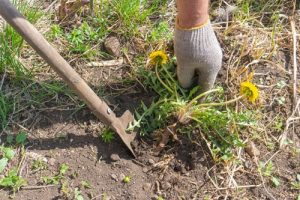 Keeping a lush, green lawn can be challenging, especially when pesky weeds invade your space. Effective weed control involves optimizing soil nutrients and water inputs, which is essential for maintaining a healthy green lawn.
Keeping a lush, green lawn can be challenging, especially when pesky weeds invade your space. Effective weed control involves optimizing soil nutrients and water inputs, which is essential for maintaining a healthy green lawn.
Fortunately, you’re in the right place. So, this article will explore how to identify common weeds and how to eliminate them from your landscape, ensuring your yard remains pristine.
Weed Control Tips For Homeowners
Common Broadleaf Weeds
Generally, broadleaf weeds are a diverse group characterized by their wide leaves. Additionally, each type features a prominent central vein, making them easy to spot. These weeds vary in appearance and root structures, with some having a fibrous root system anchored by a large taproot, while others possess a network of thinner roots. Therefore, this variety makes broadleaf weeds particularly resilient and adaptable.
1. Ground Ivy (Glechoma hederacea)
First, ground ivy, also known as creeping Charlie, spreads rapidly and is difficult to control. Therefore, identifying and tackling this weed early is crucial, as it propagates through seeds, roots, and stem fragments.
- Life cycle: Perennial
- Weed type: Broadleaf
- Where it thrives: Shady areas with moist soil.
- Identification: Creeping growth, small purple flowers, heart-shaped leaves with scalloped edges.
- Removal: Hand-pull or rake small sections, use post-emergent herbicides for larger invasions.
2. Bittercress (Cardamine hirsuta)
Then, bittercress is identifiable by the small hairs on its leaves and produces delicate white flowers. Additionally, it quickly invades areas with thin turf and high soil moisture.
- Life cycle: Winter or summer annual
- Weed type: Broadleaf
- Where it thrives: Moist environments.
- Identification: Low-growing with a basal rosette, small hairs at leaf base.
- Removal: Mow frequently, pull or dig up, use pre and post-emergent herbicides.
3. Henbit (Lamium amplexicaule)
Then, the Henbit. Generally, it is a member of the mint family, features a fibrous root system making hand weeding less effective. Therefore, post-emergent herbicides are often used for thorough control when implementing landscaping maintenance.
- Life cycle: Winter annual
- Weed type: Broadleaf
- Where it thrives: Fertile soil, full to partial shade.
- Identification: Hairy, rounded leaves, square stems, small pink to purple flowers.
- Removal: Use pre-emergent herbicides in early September or post-emergent herbicides in early November.
 Weed Control : Common Grassy Weeds
Weed Control : Common Grassy Weeds
Moreover, grassy weeds closely mimic the appearance of lawn grass, which often makes them difficult to identify and manage. Additionally, they are characterized by their long, narrow leaves with parallel veins.
1. Crabgrass (Digitaria ischaemum)
First of all, the crabgrass is a common challenge in lawn care in Conway SC. Typically, it’s known for its rapid growth. Therefore, prevention is key, and establishing a dense, healthy lawn helps prevent crabgrass seeds from germinating.
- Life cycle: Summer annual
- Weed type: Grass
- Where it thrives: Various conditions, heat, drought, full sun, and partial shade.
- Identification: Light green, noticeable nodes, coarse texture.
- Removal: Mow higher, fertilize with nitrogen, and mulch to slow germination.
2. Yellow Foxtail (Setaria glauca)
Then, the yellow foxtail has sharp seeds that can penetrate the skin, posing a risk. Moreover, it aggressively competes for nutrients, space, and sunlight with grass.
- Life cycle: Annual
- Weed type: Grass
- Where it thrives: Sunny areas, dry or moist soils, drought conditions.
- Identification: Coarse leaves, short hairs as a ligule, yellow-green seedheads.
- Removal: Hand-pull small amounts, use pre and post-emergent herbicides.
3. Dallisgrass (Paspalum dilatatum)
Dallisgrass is difficult to manage once established and thrives in nitrogen-rich soil. Therefore, regular fertilizing can inadvertently bolster its growth.
- Life cycle: Perennial
- Weed type: Grass
- Where it thrives: Moist conditions, full sun, partial shade.
- Identification: Mid-rib in leaves, raceme seed heads with hairy spikelets.
- Removal: Prevent establishment, dig out young plants, use pre and post-emergent herbicides.
4. Yellow Nutsedge (Cyperus esculentus)
Yellow nutsedge poses problems due to an underground system of tubers. Moreover, combining Conway lawn care practices with chemical and mechanical control methods is necessary.
- Life cycle: Perennial
- Weed type: Sedge
- Where it thrives: Wet areas, full sun, various conditions.
- Identification: Long, light green or yellow leaves, triangular stem, yellow spikelet flowers.
- Removal: Hand-pull, remove tubers and rhizomes, use post-emergent herbicides.
Preventing Weeds
Also, to discourage weeds, maintain a healthy lawn:
- First, feed your lawn with necessary nutrients.
- Second, water infrequently and deeply to encourage deeper root growth.
- Then, apply pre-emergent herbicides to prevent germination.
- Also, set your lawn mower blade higher to leave grass longer.
- Additionally, apply a thick layer of mulch to flower and garden beds.
So, maintaining a weed-free lawn requires dedication and the right strategies. Moreover, if you find yourself overwhelmed by the intricacies of lawn care, don’t hesitate to reach out to a local lawn care professional like Conner’s Lawn Care Service for help. Moreover, they can provide tailored solutions to ensure your lawn thrives.
Are you looking for professional weed control services? Contact Conner’s Lawn Care Service today and enjoy a beautiful, healthy lawn year-round!
Conner’s Lawn Care Service
Myrtle Beach, SC
843-504-4901
http://connerslawncare.com/